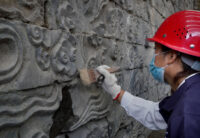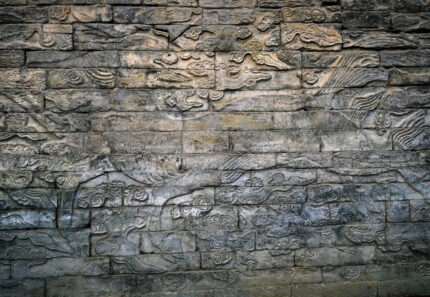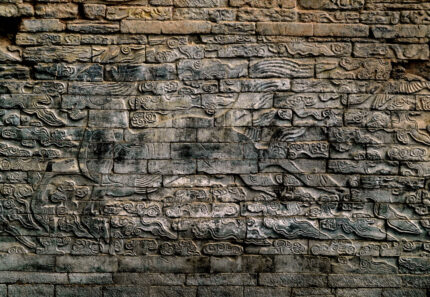Exquisitely carved stone murals have been discovered on the east side of the ancient Zhouqiao Bridge in Kaifeng in central China’s Henan Province. The murals date to the Northern Song Dynasty (960-1127). They were installed on the north and south sides of the stone walls of a pre-existing 8th century bridge. The intricate designs depict auspicious animals — mythical seahorses at swim, cranes in flight — and a profusion of small, curly clouds. The murals are symmetrically carved and are the same height: 3.3 meters (10.8 feet) high. The north bank mural is 21.2 meters (69.6 feet) long; the southern is slightly longer at 23.2 meters (76.1 feet). They are the largest Northern Song Dynasty stone relief murals ever discovered, and the excavation isn’t even done yet. Archaeologists believe they will prove to be as much as 100 feet long when fully excavated.
Kaifeng, then called Dongjing, was the capital of the Northern Song Dynasty. Art and literature from the period hail the city as the epicenter of culture and trade. Zhouqiao Bridge was built between 780 and 783 A.D. during the Tang Dynasty at the junction of Kaifeng’s main thoroughfare and the Grand Canal, the artificial riverway that connected northern and southern China and is the longest canal in the world. The bridge was refurbished and expanded in the Northern Song period, and the auspicious carvings added.
“In terms of scale, subject and style, the stone murals can represent the highest standards of the stonework system and the highest level of carving techniques during the Northern Song Dynasty,” said Zheng Yan, a professor at Peking University’s School of Arts.
“It is an important discovery that enriches and rewrites the art history of the Song Dynasty,” he added.
Not only is the carving top-notch, but the installation technique employed to create such large-scale  pieces is ingenious. The stones were carved in groups and each stone numbered. The carved stones were then assembled following the numbering system to ensure every stone was in its proper place. The two murals use two different numbering systems.
pieces is ingenious. The stones were carved in groups and each stone numbered. The carved stones were then assembled following the numbering system to ensure every stone was in its proper place. The two murals use two different numbering systems.
The bridge was in active use through the Ming Dynasty until it was buried in mud when the Yellow River flooded in 1642. Excavations at the site have been ongoing since 2018, unearthing more than 60,000 artifacts (mostly porcelain fragments).

